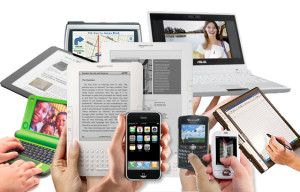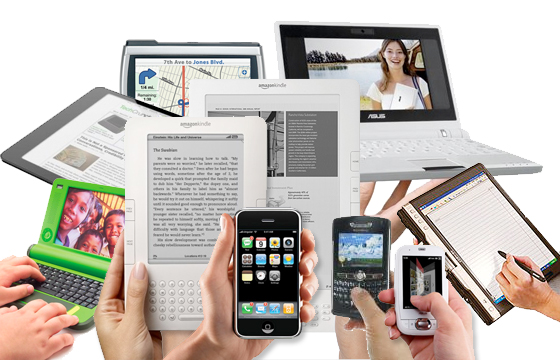Mobile Device Options
Last year, Time Magazine reported that the typical smart phone has more computing power than Apollo 11 did when it landed on the moon. That’s the kind of power we carry around in our pockets. But for many of us, so much power can be overwhelming.
 With smart phones, tablets, and e-readers so readily available, it can be hard to know where to focus our limited attention spans. Here we take a quick look at what different devices have to offer:
With smart phones, tablets, and e-readers so readily available, it can be hard to know where to focus our limited attention spans. Here we take a quick look at what different devices have to offer:
Smart Phones & Tablets
We never knew our phones had such low IQs until we met the smart phones. These little beauties changed how we connected with the world. These days, a reported 9 out of 10 adults in the US have their smart phone by there side at all times, ready to call, text, surf the web, play a game, listen to music, or sedate their children at a moment’s notice. We didn’t think it could get much better, but then we met the tablet.
Tablet devices caused some confusion when they first hit the market. They looked just like bigger versions of our smart phones, making it easier to watch programs, trade chickens on Farmville, or show off pictures of our grandkids, but they lacked the ability to make a simple phone call.
These days, tablets range from Apple’s 7-inch “mini” to HP’s 20-inch ENVY Rove. To compete with the tablets, smart phone screens are getting bigger, trying to balance functionality with the customers willingness to look ridiculous holding a 12-inch tablet to the side of their head to make a call.
E-Reader
E-Readers (such as the Kindle, Nook, and Kobo) started off as simple solutions for anyone wanting to read a lot without having to carry around a 20-pound bag of books. They generally have limited internet capability, and present their content in black and white, though that is changing. There are two main benefits to an e-reader over a tablet. First is that the “pages” are made to simulate paper (meaning that the screen of the device is not backlit), which minimizes eye fatigue. The second is cost. A basic Kindle can be purchased for $69.Even the most basic tablets come in at twice that, with most falling in the $400-600 range.
The Future
Some day there will no doubt be one magical mobile device to rule them all, something worthy of Tolkien’s imagination, that can shrink to the size of a stone to fit in our pockets then expand to display the latest movie release in all its glory, and with the touch of a button the background light will fade to allow for easy extended reading.
Until then, we will continue to tout around all three, and marvel at the many ways in which we are able to connect with the world around us.


